4 – 20 OCTOBER 2018
By Andy Walker
Overview
This 17-day customized Australia group tour commenced in Cairns, Queensland, on the 4th of October 2018 and concluded in Melbourne, Victoria, on the 20th of October 2018. The tour included a circuit around the Atherton Tablelands and surroundings from Cairns, a boat trip along the Daintree River, and a boat trip to the Great Barrier Reef (with snorkeling), a visit to the world- famous O’Reilly’s Rainforest Retreat in southern Queensland after a short flight to Brisbane, and rounded off with a circuit from Melbourne around the southern state of Victoria (and a brief but rewarding venture into southern New South Wales). The tour connected with many exciting birds and yielded a long list of eastern Australian birding specialties.
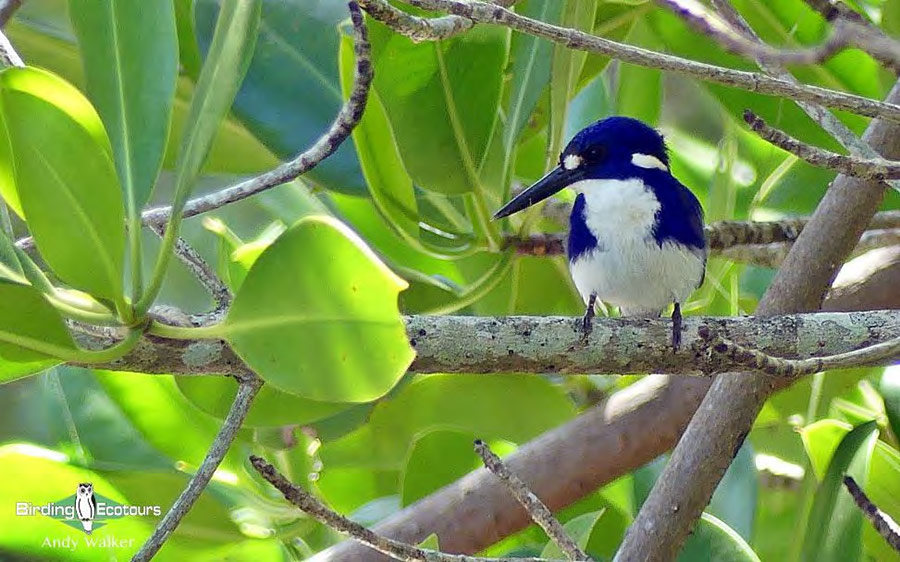
We enjoyed excellent views of Little Kingfisher during the tour.
Highlights of our time in Far North Queensland on the Cairns circuit included Southern Cassowary (a close male with chick in perfect light), hundreds of Magpie Geese, Raja Shelduck with young, Green and Cotton Pygmy Geese, Australian Brushturkey, Orange-footed Scrubfowl, Brown Quail, Squatter Pigeon, Wompoo, Superb, and perfect prolonged dawn- light views of stunning Rose-crowned Fruit Doves, displaying Australian Bustard, two nesting Papuan Frogmouths, White-browed Crake, Bush and Beach Stone-curlews (the latter with chicks), Comb-crested Jacana, Bridled and Black-naped Terns with thousands of nesting Sooty Terns and Brown Noddies on a sand cay on the Great Barrier Reef, Black-necked Stork, Great Frigatebird, Black-breasted Buzzard (an unexpected local rarity), displaying Pacific Baza, Grey Goshawk, White-bellied Sea Eagle, two Little Kingfishers sitting together, Azure Kingfisher, Laughing and Blue-winged Kookaburras, Rainbow Bee-eater, Red-tailed Black Cockatoo, Sulphur-crested Cockatoo, fig-eating and perched Double-eyed Fig Parrot, Spotted Catbird, displaying Tooth-billed and Great Bowerbirds, Bridled and Macleay’s Honeyeaters, Fernwren, Atherton Scrubwren, Mountain Thornbill, very close-up Chowchilla, Yellow- breasted Boatbill, Black Butcherbird, a dozen fruit-feeding Barred Cuckooshrikes, White- winged and Varied Trillers, confiding Bower’s and Little Shrikethrushes, White-eared, Pied, Black-faced, and Spectacled Monarchs, nearly-displaying Victoria’s Riflebird on song perch, Pale Yellow, Mangrove, Grey-headed, and White-browed Robins, Crimson and Double- barred Finches, and numerous gorgeous Chestnut-breasted Mannikins.
Highlights of our brief trip from Brisbane included White-headed, Topknot, and Wonga Pigeons, Baillon’s and Spotless Crakes, Red-necked Avocet, adult and immature Black-necked Storks, a pair of nesting White-bellied Sea Eagles, Torresian Kingfisher, close views of feeding Glossy Black Cockatoos, very friendly Australian King Parrots and Crimson Rosellas, as well as Pale-headed and Eastern Rosellas, Little Lorikeet, Albert’s Lyrebird making us work at first before giving incredible views, Green Catbird, very showy Regent and Satin Bowerbirds, gorgeous, tiny, and very colorful Variegated, Superb, and Red-backed Fairywrens, Mangrove Gerygone (plain but with a beautiful song), comical foraging Australian Logrunner, explosive- singing Eastern Whipbird, displaying Tawny Grassbird, ubiquitous Eastern Yellow Robin, and Bassian and Russet-tailed Thrushes, the latter found on its nest.
Finally, highlights of our circuit around Victoria (with a brief sortie into New South Wales) included Emu, Cape Barren Goose, Freckled Duck, the bizarre and huge Musk Duck, highly- prized Malleefowl, nesting Tawny Frogmouth, three Australian Owlet-nightjars, two large flocks of Black-tailed Nativehens, nesting Brolga, Banded Stilt, Banded Lapwing, beach- nesting Hooded Plover, magical views of the rare Inland Dotterel and male Plains-wanderer on
a night drive, very close views of Little Penguin, numerous Shy Albatrosses and a vagrant Buller’s Albatross, Nankeen Night Heron, Little and Wedge-tailed Eagles, Powerful Owl, Southern Boobook, Yellow-tailed Black Cockatoo, the gorgeous Major Mitchell’s Cockatoo crest-flashing, numerous colorful parrots including Superb, Regent, Mulga, Blue-winged, and Turquoise Parrots, Superb Lyrebird, Mallee and Southern Emu-wrens, Striated Grasswren, some very popular Purple-backed, Splendid, and White-winged Fairywrens, dozens of honeyeaters, the secretive Pilotbird, Crested Shriketit, Olive and Gilbert’s Whistlers, definitely twelve Apostlebirds, White-winged Chough, Red-capped, Flame, Rose, and Pink Robins providing yet more color, Southern Scrub Robin, White-backed Swallow, Little Grassbird, Diamond Firetail, and Zebra and Double-barred Finches.
A total of 390 bird species were seen (plus five species heard only), along with an impressive list of other animals, including Platypus, Short-beaked Echidna, Koala, Lumholtz’s Tree Kangaroo, Red, Western, and Eastern Grey Kangaroos, Green Ringtail Possum, Striped Possum, (Southern) Greater Glider, Sugar Glider, Saltwater Crocodile, and Green Turtle.
Full species lists are provided at the end of this report.

Platypus showed incredibly well at dusk in Queensland.
Detailed Report
Day 0, 3rd October 2018. Pre-tour arrival in Cairns
The group of eight arrived during the day before of the start of the tour the following morning with time spent at leisure.
Day 1, 4th October 2018. Cairns
The morning was spent birding around the Cairns Botanical Garden and Centenary Lakes. As it was our first day birding in the country we enjoyed all the birds seen, including all of the common birds that we’d become very familiar with over the coming weeks, as well as a selection of very special, much scarcer birds. As we walked around the small waterbodies we found Australian Pelican, Australian White Ibis, Pacific Black Duck, Orange-footed Scrubfowl, Australian Brushturkey, and our first Laughing Kookaburra of the trip, along with Olive-backed Sunbird, Torresian Imperial Pigeon, Australian Swiftlet, White-breasted Woodswallow, Australian Figbird, the gorgeous and abundant Rainbow Lorikeet, Sulphur-crested Cockatoo, Green Oriole, Spangled Drongo, Yellow Honeyeater, Mistletoebird, Rainbow Bee-eater, and ‘Gould’s’ Little Bronze Cuckoo. However, the best birds of our time here were quite easily the pair of Little Kingfishers that gave exceptional views, followed by a Grey Goshawk, which flew gracefully overhead before landing in full view for a few moments, allowing close study in the Swarovski ATX-95 telescope, several pairs of Black Butcherbirds, a family group of the local Raja Shelducks, and a pair of Bush Stone-curlews with two young. It was certainly a fun morning to get the tour list going with some very colorful and interesting species.
After a very nice café lunch back in Cairns we ambled across to the world-famous Cairns Esplanade, where we enjoyed watching the huge day roosts of Spectacled Flying Fox (including many with babies). We then spent a couple of hours watching the beach as the tide came in, pushing 18 species of shorebird into very close range. The highlight here (although only a flyby) was a pair of huge Beach Stone-curlews, an often tricky species to find. The many shorebirds included Terek Sandpiper, Grey-tailed Tattler, Great Knot, Broad-billed Sandpiper, Red-necked Stint, Curlew Sandpiper, Far Eastern Curlew, Sharp-tailed Sandpiper, Marsh Sandpiper, Common Greenshank, Lesser and Greater Sand Plovers, and Black-fronted Dotterel. Silver Gulls, Australian Pelicans, and Gull-billed Terns were numerous along the beach, and Eastern Osprey, Sacred Kingfisher, Welcome Swallow, and Varied Honeyeater were noted too.
As the tide continued to come in we decided to take a rest for the last hour or so of the afternoon with time to reflect on the many wonderful and new birds seen during the day.
Day 2, 5th October 2018. The Great Barrier Reef
After breakfast we headed out of Cairns by boat to the Great Barrier Reef. As we waited to depart the marina we saw our first Pacific Reef Heron, Striated Heron, and Greater Crested Terns of the tour. After an hour or so at sea (with some brief glimpses of Common Bottlenose Dolphins) we arrived at Michaelmas Cay, a fantastic sight with crystal-clear seas and the sound of thousands of terns resonating around. After an introduction to the area we landed on the cay, where we were greeted by a pair of Brown Boobies and several Great Frigatebirds right on the edge of the beach,
both giving great, close views. We spent some time looking through the many Sooty Terns, picking out several Bridled Terns, and we scoured the thousands of Brown Noddies in the hope of seeing Black Noddy, but it wasn’t to be today (the one seen briefly during a safety briefing vanishing before the group could be gathered). Greater Crested Terns and Lesser Crested Terns were plentiful and gave good comparison views as they sat close to each other. A pair of Black- naped Terns was a nice sight too. Ruddy Turnstone was the only shorebird noted on the island, but it did show well.
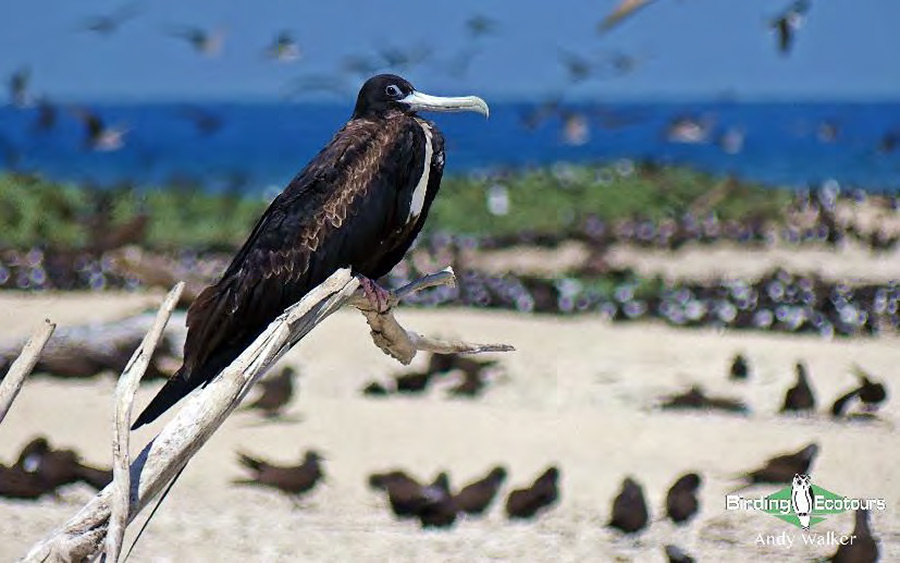
Great Frigatebird resting on the cay with hundreds of Sooty Terns, Brown Noddies, and Brown Boobies in the background
Our trip to the Great Barrier Reef was not solely about birds, however, and it would be a great shame not to venture into the water, so we all enjoyed a couple of fun snorkeling sessions and trips over the reef in a glass-bottomed boat around Michaelmas Cay and Hastings Reef, and in doing so we found Green Turtle, Manta Ray, and Tawny Nurse Shark, along with hundreds of species of stunningly beautiful fish. It is always a magnificent sight underwater here with some amazing corals too, of course. As always the team on the boat were exemplary and made this a fun and enjoyable trip.
After finishing the reef trip we headed back to Cairns, collected our bags and local guide Ben, and headed south to Innisfail for the night, seeing our first Straw-necked Ibis, White-necked Heron, Fairy Martin, and Black Kites along the way.
Day 3, 6th October 2018. Innisfail to Yungaburra and the Atherton Tablelands
Today was sure to rank as one of the best days of the tour. We found Southern Cassowary along the coast near Innisfail (an adult male and chick), with Rose-crowned and Superb Fruit Doves, Barred Cuckooshrike, Metallic Starling, Spangled Drongo, and Double-eyed Fig Parrot also in attendance here. As we headed to the Atherton Tablelands we found Satin Bowerbird, Victoria’s Riflebird (a member of the much-sought birds-of-paradise family), Grey Whistler, and Bower’s Shrikethrush, along with several other species.
After lunch we stopped at Hasties Swamp National Park near Atherton, where we enjoyed a couple of hours watching the water, getting plenty of new trip birds. Plumed Whistling Ducks were plentiful, as were Pink-eared Ducks. Also present were Grey Teal, Hardhead, and Maned Duck. We found a couple of Latham’s Snipes, Marsh Sandpiper, Red-kneed Dotterel, and Black-fronted Dotterel. Buff-banded Rail was present but distant. Whistling Kites were present here, as was Nankeen Kestrel, Australian Swamphen, Brown Cuckoo-Dove, Macleay’s Honeyeater, Little Shrikethrush, and Chestnut-breasted Mannikin.
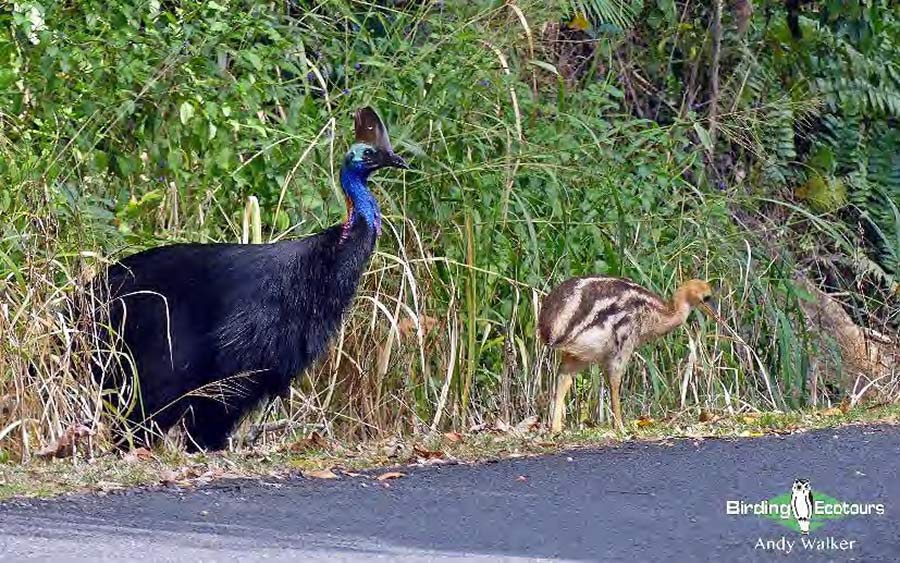
A male Southern Cassowary with his chick appeared along the side of the road, where they gave us some incredible views as they walked right by us and into the forest, where they vanished.
As the afternoon wore on we stopped at a river, where we found our first Platypus of the trip, with fantastic views having had in the end. We were also distracted from our platypus views by Sarus Crane, Varied Triller, Pacific Baza, Red-backed Fairywren, Scarlet Myzomela, White- cheeked Honeyeater, Spectacled Monarch, and Fan-tailed Cuckoo.
After dinner we ventured out near our accommodation and had a brief but great mammal-watching drive and walk, during which we struck gold and found the rare and secretive Lumholtz’s Tree Kangaroo. We also saw Green Ringtail Possum, the copper form of Common Brushtail
Possum (sometimes split into its own species, “Copper Brushtail Possum”), Striped Possum, Sugar Glider, White-tailed Rat, and Eastern Barn Owl. It was a very long day, but it was incredibly rewarding.
Day 4, 7th October 2018. Atherton Tablelands to Julatten
After breakfast we spent a few hours birding around Lake Eacham, where we had excellent views of a male Victoria’s Riflebird on a display perch. Although he didn’t go into display mode (the females were all busy feeding) he did do a few stretches and vocalizations, which was great to see (check out the Birding Ecotours YouTube page for some video of this). Here we also enjoyed seeing Spotted Catbird, Wompoo Fruit Dove, Grey-headed Robin, Yellow-breasted Boatbill, Brown Cuckoo Dove, Australian Golden Whistler, Double-toothed Bowerbird (including a male bringing a fresh leaf to his bower), Pale-headed Rosella, Pale Yellow Robin, and Spectacled Monarch.
Our next stops included Lake Barrine, The Curtain Fig Tree, and Yungaburra, where we found Yellow-throated Scrubwren, Topknot Pigeon, Sarus Crane, and many of the aforementioned species, along with Musky Rat Kangaroo, Saw-shelled Turtle, and Boyd’s Forest Dragon.
After lunch we headed north, adding Little Red Flying Fox, Red-tailed Black Cockatoo, Great Bowerbird, White-browed Robin, White-eared Monarch, Bar-shouldered Dove, Graceful, Yellow, and Brown-backed Honeyeaters, Rufous Whistler, Blue-winged Kookaburra, Red- winged Parrot, Little Friarbird, and Double-barred Finch. We also were able to watch a mob of very relaxed Eastern Grey Kangaroos, which was a real treat.
In the midafternoon we arrived at our accommodation for the next two nights, the wonderful Kingfisher Park Birdwatchers Lodge. Here we spent the last hours of the day watching Metallic Starling, Red-browed Finch, Spectacled Monarch, Chestnut-breasted Mannikin, Pale Yellow Robin, Australasian Brushturkey, Orange-footed Scrubfowl, and Macleay’s Honeyeater outside our rooms. A night walk around the property was quiet, but we did see Eastern Barn Owl and Red-legged Pademelon.
Day 5, 8th October 2018. Kingfisher Park and the Mount Lewis area
Some of the group were awakened in the early hours by a vocal Lesser Sooty Owl outside the rooms!
A pre-breakfast birding session near to Kingfisher Park Birdwatchers Lodge with local guide Carol provided plenty of new and exciting birds, one of the best being the first bird we saw, a beautiful female Black-necked Stork, soon followed by Cotton Pygmy Goose, White-bellied Cuckooshrike, Wandering Whistling Duck, Comb-crested Jacana, Little Egret, Red-backed Fairywren, and Golden-headed Cisticola. A fruiting fig tree gave us our first perched views of the diminutive Double-eyed Fig Parrot. It was great to be able to watch the bird for a prolonged period while it fed. There were lots of pigeons and doves present, such as Superb Fruit Dove (very shy with a brief view but lots of vocalizations), Topknot Pigeon, Brown Cuckoo-Dove, Torresian Imperial Pigeon, and Pacific Emerald Dove.
After a delicious breakfast we headed to Mount Lewis National Park, gaining some elevation. Here the birds changed slightly, and we found several new and restricted-range species, such as
Fernwren, Chowchilla, Atherton Scrubwren, Mountain Thornbill, Bridled Honeyeater, Grey Fantail (the local subspecies), Spotted Catbird, Victoria’s Riflebird, Bower’s Shrikethrush, and Grey-headed Robin. Other more widespread species seen included Yellow- throated Scrubwren, Australian Golden Whistler, Lewin’s Honeyeater, Mistletoebird, and Rainbow Bee-eater.
After a wonderful lunch, where we sat relaxing and watching Macleay’s Honeyeater, Red- browed Finch, Orange-footed Scrubfowl, Australian Brushturkey, and Bar-shouldered Dove, we headed down the mountain to the dry areas of Mount Molloy and Mount Carbine, where we found some excellent birds, the best of them being an unexpected Black-breasted Buzzard as we were watching a displaying Australian Bustard! Other high-quality birds included Squatter Pigeon, Red-winged Parrot, Red-tailed Black Cockatoo, Great Bowerbird, Brown Quail, White-winged Triller, Noisy Friarbird, Little Friarbird, and Brown Falcon.
Day 6, 9th October 2018. Daintree River cruise and travel to Cairns
We departed the excellent Kingfisher Park Birdwatchers Lodge early in the morning in time to make our dawn boat trip along the Daintree River with local boatman Murray. We had lots of great birds during our two-hour cruise, with the two nesting Papuan Frogmouths being very high up the list of favorite birds. Other quality was provided by White-browed Crake, Azure Kingfisher, White-bellied Sea Eagle, Raja Shelduck, Pacific Koel, Shining Flycatcher, Pied Monarch, and excellent views of Green Oriole feeding at eye-level. It wasn’t all about the birds, though, as we were all very impressed by the four Common (Green) Tree Snakes and a four-meter-long Saltwater Crocodile we saw along the river.
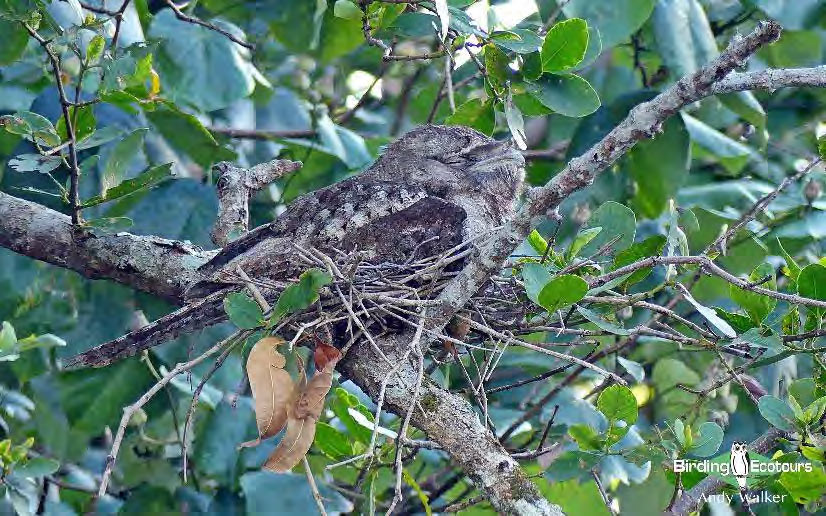
It was great to see two pairs of nesting Papuan Frogmouths while on the river cruise.
After the conclusion of our boat trip we started our journey back toward Cairns. Stops along the way gave us good views of Crimson Finch, Little Tern, Wandering Whistling Duck, Green Pygmy Goose, Latham’s Snipe, Black Butcherbird, Rufous Fantail, Grey Whistler, and White-eared Monarch. Our final bird of this circuit out of Cairns was a very obliging Mangrove Robin, which showed extremely well close to our hotel.
We said goodbye and a huge thank you to local guide and driver Ben and grabbed an early night in anticipation of our early start the following morning.
Day 7, 10th October 2018. Flight to Brisbane and travel to Lamington National Park
We had a very early departure from Cairns for our two-hour flight to Brisbane, where we arrived around 8 a.m. We then spent a few hours birding around Brisbane before we headed south to Lamington National Park and the world-famous O’Reilly’s Rainforest Retreat, where we arrived in the midafternoon. Our birding around Brisbane yielded several new species, the best of which being sightings of both the secretive Spotless Crake and Baillon’s Crake and the equally furtive Brown Quail. We also had great looks at Mangrove Gerygone, Torresian Kingfisher, Red- necked Avocet, Pied Stilt, Variegated, Superb, and Red-backed Fairywrens, Tawny Grassbird, Striped Honeyeater, Grey Shrikethrush, Eastern Osprey (with young on a nest), Pheasant Coucal, Torresian Crow, and a few new species of wildfowl such as Black Swan, Chestnut Teal, and Dusky Moorhen, as well as further looks at several species we’d started to become familiar with. We also saw a few impressive Eastern Water Dragons.
As we drove up to O’Reilly’s we found our first Whiptail Wallaby, and a stop for the interesting and ever-vocal Bell Miner fortuitously yielded a pair of the rare and secretive Glossy Black Cockatoos to much delight!
After a brief rest after checking into our rooms we took an hour’s walk around the lodge car park. Here new birds were literally all around us, and it was hard to know where to look! Crimson Rosella, Australian King Parrot, Satin Bowerbird, Regent Bowerbird, Wonga Pigeon, Australian Logrunner, Eastern Whipbird, Eastern Yellow Robin, Eastern Spinebill, Pied Currawong, White-browed Scrubwren, and Brown Thornbill all vied for our attention We also improved our views of Superb Fairywren from earlier in the day with two dazzling males hopping about on the lawn, soon followed by a Red-necked Pademelon. A short while later we called it a day because of a huge thunderstorm, which was impressive to watch and listen to but did unfortunately prevent any night walk, although a Common Brushtail Possum was near the dining room.
Day 8, 11th October 2018. Full day O’Reilly’s and Lamington National Park
The weather really did not help with strong wind, cold temperatures, and occasional heavy rain and drizzle as we spent the full day birding around O’Reilly’s and Lamington National Park. However, that said we still found some good birds, it was just harder than usual. Top of the bill went to the local and rare Albert’s Lyrebird. which we eventually located after a lot of walking around on the various trail systems. We also saw several Green Catbirds, the best views being of four birds feeding in a fruiting tree with a couple of Topknot Pigeons. One of the best finds of the day was a nesting pair of Bassian Thrushes, a beautiful, cryptically-plumaged bird. We also had some fantastic views of Australian Logrunner, with several pairs feeding practically at our feet!
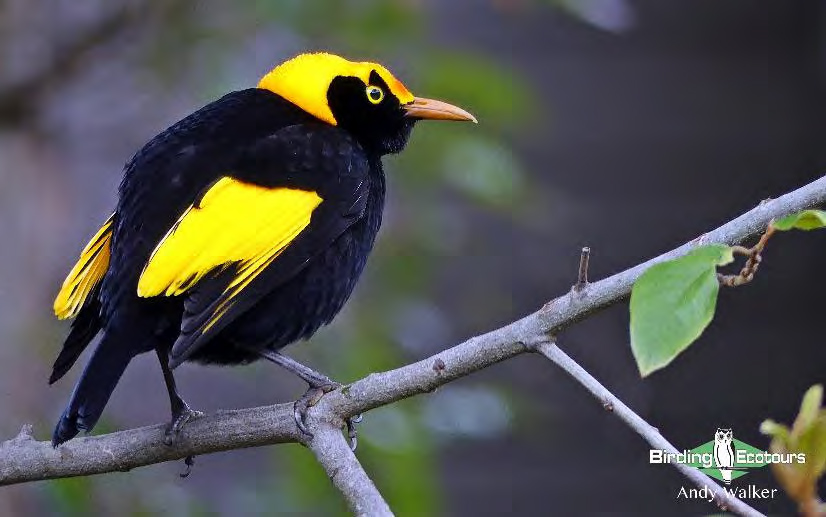
The Regent Bowerbird is simply stunning!
The usual spectacular and showy birds were everywhere too, like Regent Bowerbird, Satin Bowerbird, Crimson Rosella, Australian King Parrot, Eastern Yellow Robin, Australian Golden Whistler, Eastern Whipbird, etc.
Unfortunately the wind and rain continued into the night and prevented a night walk. However, we did see Red-legged and Red-necked Pademelons during the day on our walks.
Day 9, 12th October 2018. O’Reilly’s and Lamington National Park, flight to Melbourne
We had time for a few hours’ pre-breakfast birding from O’Reilly’s, during which we saw two Albert’s Lyrebirds (the same individual as the previous day and a different bird – a young male). One of the first species we saw was a pair of Russet-tailed Thrushes, and a short while later, on a different trail, we again saw the pair of Bassian Thrushes we had found nesting the previous day. So it was great to be able to compare these two species within half an hour or so of each other. We had a few more Australian Logrunners, Green Catbirds, Regent Bowerbirds, Satin Bowerbirds, and the usual showy suspects, but both Noisy Pitta and Paradise Riflebird remained ‘heard only’ in the continuing poor, windy weather.
After a late breakfast we checked out of the wonderful O’Reilly’s Rainforest Retreat (you could easily spend a week here and not get bored). We made our way off the mountain, stopping briefly for a wine-tasting session at O’Reilly’s Canungra Valley Vineyards. As well as sampling some very nice red wines we saw our first Galahs and had further looks at Scaly-breasted Lorikeet, Little Friarbird, Australian Magpie, and Straw-necked Ibis.
As we continued toward the airport a brief stop at a dam near Tamborine yielded over 30 species! A pair of White-bellied Sea Eagles were the reason for the stop, but this led us to seeing an adult and an immature Black-necked Stork, Little, Scaly-breasted, and Rainbow Lorikeets, Little Corella, Eastern and Pale-headed Rosellas, and Pied Butcherbird. Not bad for 15 minutes!
After a stress-free check-in for our flight to Melbourne we had lunch and passed through security. We arrived in Melbourne in the early evening and made our way the short distance to our hotel for the night, ready to set off on our circuit of Victoria the following day.
Day 10, 13th October 2018. Melbourne to Airey’s Inlet
We met up with our local guide Simon after breakfast and set off for our circuit around Victoria. It was a great (if somewhat breezy) day, and we recorded 112 species (without even going full tilt!). Our first stop was in Eynesbury, to the west of Melbourne, where we found the rare and local Freckled Duck. Here we also had our first proper looks at Tree Martin, Little Eagle, Galah, Eastern Rosella, Red-rumped Parrot, Little Grassbird, Brown Treecreeper, Red Wattlebird, White-plumed Honeyeater, Dusky Woodswallow, Little Raven, Common Blackbird, European Goldfinch, the delightful Diamond Firetail, and a few Purple-crowned Lorikeets. We then headed in to the You Yangs, where we encountered a pair of Tawny Frogmouths sitting near to a recently-failed nesting attempt as well as our first Spotted Pardalote and Weebill (Australia’s smallest bird) of the trip. A final stop before lunch in Lara yielded the local Cape Barren Goose, along with Yellow-rumped Thornbill at a nest, and a couple of introduced species: the very local Eurasian Tree Sparrow, and the somewhat-more-widespread European Greenfinch.
After lunch we headed to the coast at Avalon Beach. Here we found the local endemic Banded Stilt (along with Pied Stilt and Red-necked Avocet). Other shorebirds included our first Pied Oystercatcher along with Curlew Sandpiper, Sharp-tailed Sandpiper, and Red-necked Stint. Other new birds here included Australian Crake, Pacific Gull (one of the best gulls in the world!), Swamp Harrier, and displaying Eurasian Skylark.
As we moved west along the Great Ocean Road we saw a small flock of Yellow-tailed Black Cockatoos flying across the famous route. A couple of nearby stops gave us plenty to look at, including Hoary-headed Grebe, Horsfield’s Bronze Cuckoo, White-throated Treecreeper, Little Wattlebird, New Holland, Brown-headed, White-eared, and White-naped Honeyeaters, Striated Pardalote, Bassian Thrush, Varied Sittella, Eastern Yellow Robin, and a lovely male Crested Shriketit in the perfect evening sunshine. Our final stop of the day in a small area of very picturesque heathland gave us our final two new birds of a day full of new birds, Southern Emu-wren and Striated Fieldwren.
Day 11, 14th October 2018. Airey’s Inlet to central Victoria
We packed a lot in during a long day but were handsomely rewarded with some really great birds. Our first stop, just down the road from where we were staying, was for the local Rufous Bristlebird, of which we got some excellent views. A sea watch here was very rewarding with some lucky people getting a close fly-by Buller’s Albatross! We all also got to see Shy Albatross and Australasian Gannet. Other prized species here included Blue-winged Parrot, Singing Honeyeater, and Grey Currawong.
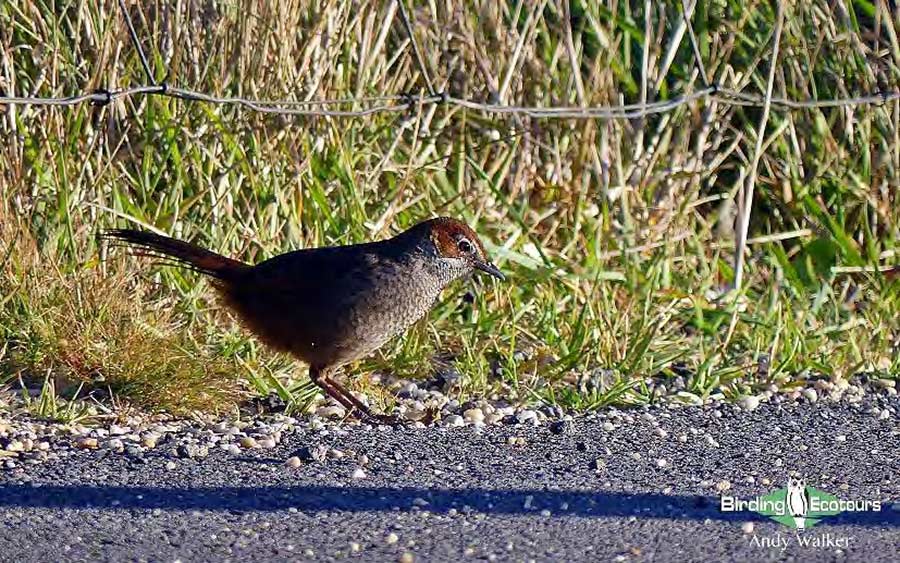
Rufous Bristlebird is from an ancient lineage of passerines and is a member of an Australian- endemic family; it is very locally distributed in southern Australia and also has a beautiful song.
After breakfast we headed a short distance to the east, where we were soon watching even more Shy Albatrosses close offshore, but also our main target bird, the rare endemic Hooded Dotterel. Other species included Caspian and Greater Crested Terns. It was great to see the nesting dotterels, and we just hope that they survive the many pressures of beach life in Australia.
While heading back west along the Great Ocean Road a brief stop gave us our first Australian Pied Cormorant, and then a short while later we were watching a Koala. Unfortunately it wasn’t doing an awful lot (they are generally nocturnal), but it was still nice to be able to see one in the wild.
After a rather nice lunch in a small village we continued our journey north, away from the coast. A stop in Ballarat gave our day lists a boost with lots of wildfowl, which included a couple of surprises in Magpie Goose, Blue-billed Duck, Pink-eared Duck, and Swamp Harrier. A stop along a river provided us the rare opportunity to see the wonderful Powerful Owl, and here we also found our first Common Bronzewings and Musk Lorikeets, while nearby we also saw our first White-winged Choughs, typically lazily crossing the road. As we were driving around we also enjoyed both Little and Long-billed Corellas along with plenty of pretty Galahs and Sulphur-crested Cockatoos and several mobs of Eastern Grey Kangaroos, including a female with a joey in the pouch.
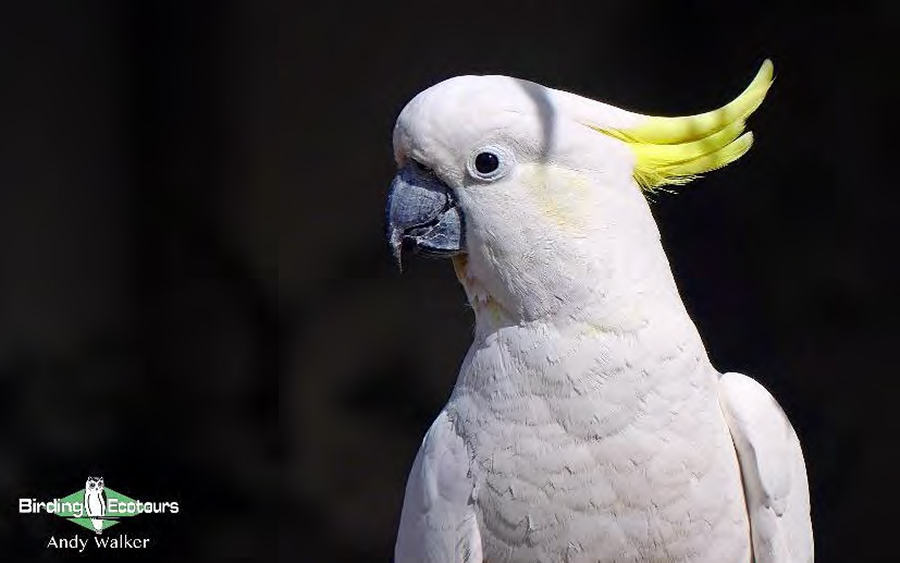
Sulphur-crested Cockatoo is a common bird and was seen on most days of the tour, which isn’t a problem when it looks as incredible as this.
Our final stop of the day was in a patch of flowering Yellow Box and River Red Gum. Here we had a bonanza of new birds, such as Pallid Cuckoo, White-browed and Masked Woodswallows (the former being one of the best-looking woodswallows in the world), Black-chinned, Yellow- tufted, and Fuscous Honeyeaters, as well as Diamond Firetail, Red Wattlebird, and Dusky Woodswallow. A tremendous end to the day!
Day 12, 15th October 2018. Central Victoria to Ouyen
We started in Inglewood and wasted no time getting our birding underway with some great (and beautiful) birds such as Gilbert’s Whistler, Shy Heathwren, White-backed Swallow, Common Bronzewing, Brush Bronzewing, Tawny-crowned Honeyeater, White-fronted Honeyeater, Yellow-plumed Honeyeater, Little Corella, Long-billed Corella, and Australian Hobby.
We started our journey away from Inglewood and stopped at a couple of lakes, agricultural fields, and parkland areas, where we found roosting Nankeen Night Heron and nesting Tawny Frogmouth along with the rare and localized (in Victoria) Grey-crowned Babbler, Eastern Bluebonnet, White-winged Fairywren, and Horsfield’s Bush Lark.
After lunch we called in ar Cullens Lake, which was rammed full of waterfowl, and it really was a spectacular sight; thousands of birds were present all around the waterbody. We found several new species for our trip in the form of Australian Shelduck, Australasian Shoveler, Black-tailed Nativehen, and Yellow-billed Spoonbill. Nearby we also found a large number of the bizarre (and huge) Musk Duck, with the flowering vegetation full of Black Honeyeaters and a small flock of the tiny Zebra Finch and a couple of White-winged Trillers also present.
Our final stop of the day was at the salt lake of Lake Tyrrell. Here it was not waterfowl we were looking for but birds inhabiting the saltbush and nearby scrub, and we found Emu, Purple-backed Fairywren, White-fronted Chat, and Rufous Fieldwren. As we arrived in Ouyen for the night we were all very excited to find a gorgeous Major Mitchell’s Cockatoo – our last bird of the day was a very, very special one!
When Major Mitchell’s Cockatoo raises its crest there is usually a gasp from those observing, and this sighting was no different. What a bird!
Day 13, 16th October 2018. Hattah-Kulkyne National Park
We had the full day birding the wonderful Hattah-Kulkyne National Park, a huge area of mallee woodland. Our first big target of the day, Malleefowl, performed really well when we found it, and we had some fantastic, prolonged views of a foraging bird. Here we also had our first looks at the huge Red Kangaroo as well as our best views to date of Western Grey Kangaroo. A short while later we were watching perched Regent Parrots after we had seen several flocks fly over while we were enjoying the megapode. During our breakfast break we were very lucky when another Major Mitchell’s Cockatoo flew in and landed right next to us, even showing its rather fancy, colorful headgear!
After breakfast we headed into the bush, where we searched for Mallee Emu-wren. After hiking for a while (and seeing a very cool Shingleback Lizard and a couple of Mallee Dragons) we heard the emu-wren calling but unfortunately it was not seen by many people, it seemed to be a very shy individual. While walking around here we also found White-browed Woodswallow, Yellow-plumed Honeyeater, and Striped Honeyeater. Prior to lunch we saw a small flock of Southern Whiteface and the first one of the well-named Splendid Fairywren, a truly stunning bird. A stand of tall, old River Red Gum trees was very active with parrots, and we found nesting
Regent Parrots, Crimson (Yellow) Rosella, Little Corella, Australian Ringneck, and Sulphur- crested Cockatoo. Here we also enjoyed a nesting Striated Pardalote.
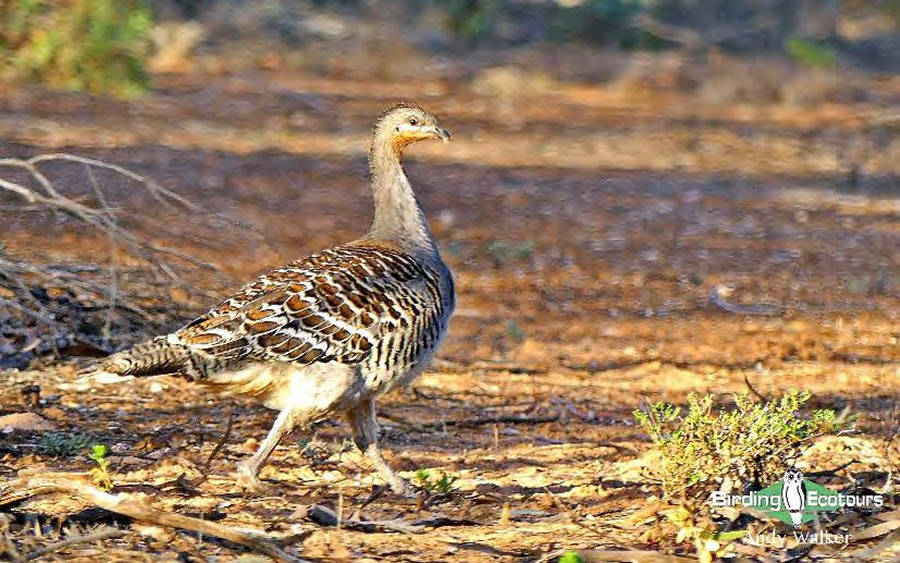
We were lucky and had some amazing views of Malleefowl in glorious early-morning light.
After a quick lunch we again headed out birding and found a Central Bearded Dragon. While looking at this beautiful lizard there was a mixed flock of thornbills passing through, containing Yellow, Inland, and Chestnut-rumped Thornbills, and we had further views of Splendid Fairywren and another one of our targets, a dozen (there must have been) very friendly Apostlebirds. We were pleased that we had stopped for the lizard! After getting these targets we headed out for another walk through some bush, where we found three excellent species in Chestnut-crowned Babblers, Southern Scrub Robin, and, best of all, Australian Owlet- nightjar.
Very happy with this haul we headed back to town for an early dinner. A brief stop along the way for Striated Grasswren nearly paid off. It came towards us calling, but again, like the emu-wren, didn’t show to all. Frustrating, but that’s sometime the way things go with these very rare and secretive species. On the whole we had seen some incredible birds during the day, so we finished happy.
A brief post-dinner birding session at a waterhole provided brief views of Australian Raven, Peregrine Falcon, and a minimum of 44 Common Bronzewing pigeons coming to drink.
Day 14, 17th October 2018. Ouyen to Deniliquin, in the evening Plains-wanderer trip
Given the late night planned for the evening we had a late start and a relaxed day’s birding, although we still saw plenty of new birds. Some highlights as we left the mallee habitat were Red-capped Robin, White-browed Treecreeper, White-browed Babbler, Hooded Robin, and Mulga Parrot. All great birds, and most gave fantastic views.
As we continued our journey towards the Victoria border a brief stop at Lake Tutchewop gave us our first proper looks at Wedge-tailed Eagle. It was well worth the wait, with a pair in flight and then perched next to each other on adjacent fenceposts, allowing excellent comparative views of the marked size difference between the large female and the smaller male. Here we also found our first and only Orange Chats of the trip, two pairs, the males glowing nice and bright.
Nearby a small waterbody held a couple of male Mallards, and as we crossed into New South Wales we came across a large paddock with a family group of Common Ostrich. The birds in this area are considered wild but of ‘dubious origin’, but they seem to be a self-sustaining population having been present for many years.
After checking into our hotel in Deniliquin we drove north into the Riverina region of New South Wales and the Hay Plains, where we met up with local expert Phil and landowner Robert. Our evening was to be spent looking for one key bird, and one very important one at that. However, before it got dark we enjoyed looking at a flock of Banded Lapwings, a pair of Wedge-tailed Eagles sitting on a nest, and finally a colored male (two in fact) of White-winged Fairywrens, after having seen dozens of females/brown birds over the last couple of days. We also could study at close range three species of kangaroo, with Red, Eastern Grey, and Western Grey Kangaroo all present. Just at sunset we saw an Eastern Barn Owl, ate our picnic dinner, and then the fun started…
This year the plains had been incredibly dry, with far lower amounts of rainfall than usual, and so we knew we would be in for a tough night. However, knowing that there had been eight millimeters of rainfall the previous day had given us some hope. As we set off in the darkness we were soon watching two Australian Owlet-nightjars, quickly followed by several Common Brushtail Possums, Fat-tailed Dunnart, Eastern Banjo Frog, Common Spadefoot Toad, Horsfield’s Bush Lark, and Australian Pipit. We were concentrating our efforts on one bird, and eventually we located our main prize of the night, the Critically Endangered (IUCN) Plains-wanderer.
The relief was huge; against all odds we’d found the bird we had all been dreaming to see, and it was not disappointing. We spent some time with this male and soaked in the real beauty of this tiny, even strange-looking bird. But then, not wanting to disturb it for too long, we went on our way, looking for one last target. Again, after some searching of suitable habitat we found ourselves eye to eye with the highly-nomadic and highly-sought Inland Dotterel, another magnificent bird (and usually the top bird on any day list or trip list!). The evening was a great success, and we all owe Phil and Robert a huge debt of gratitude for all they do for this species and those who want to try and see it.
After a careful drive back to town, dodging the kangaroos (thanks Simon!), it was time for bed, although it was difficult to sleep due to the adrenaline still pumping and the calling Southern Boobook outside the rooms!
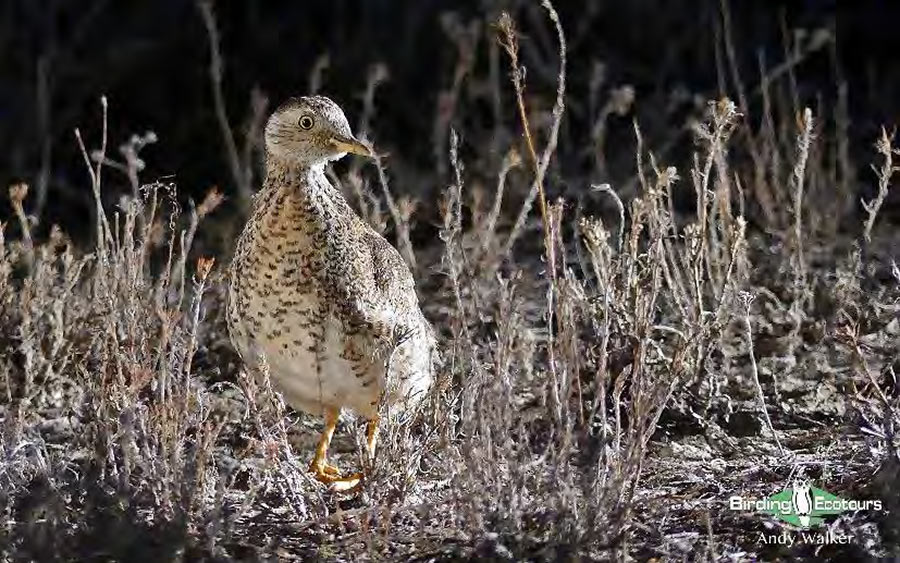
Plains-wanderer was our main target, and after an extensive search we found this male bird. As Tom so perfectly put it, “we were looking for a tiny needle in a giant haystack, in the dark!” Luck was certainly on our side, given how dry the area was, and we were very thankful to see it.
It had been a long day, but again the birds and wildlife seen during the day (and night) had made it all totally worthwhile. It was a real privilege to be able to get out onto the plains to search for these wonderful animals.
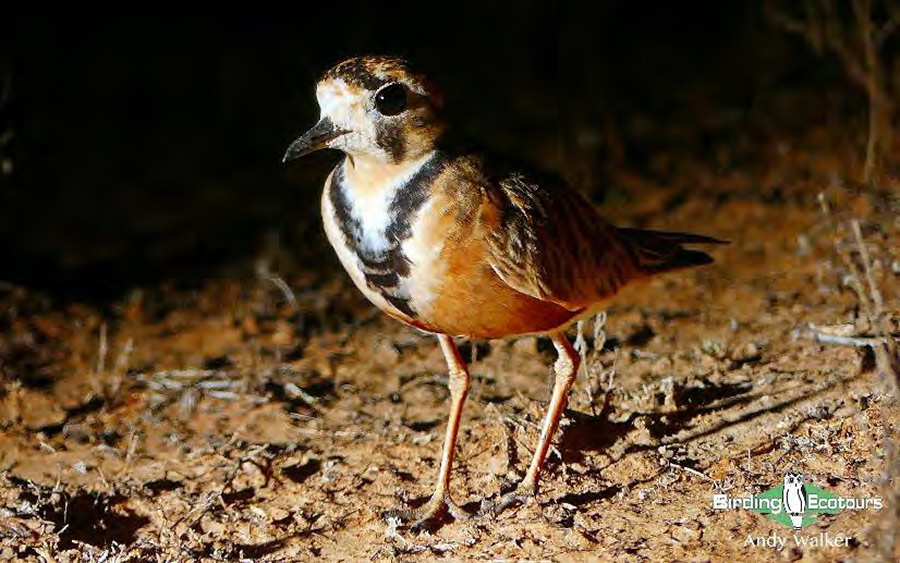
Another great bird from our night trip was Inland Dotterel, which showed particularly well.
Day 15, 18th October 2018. Deniliquin to Chiltern via Gulpa Island
We had a relaxed start to the day after our late-night adventures the previous evening, and we were all still pretty excited about our Plains-wanderer success. Our first port of call, after breakfast, was a small island sanctuary, full of stunning giant River Red Gums. It didn’t take long to find what we were looking for, the gorgeous and local Superb Parrot, but we had to search through stacks of Eastern Rosella, Crimson (Yellow) Rosella, Galah, Long-billed Corella, Little Corella, Sulphur-crested Cockatoo, and Red-rumped Parrot in doing so. This place is a parrot-lover’s paradise! Walking around the reserve we also found Nankeen Night Heron, Little and Noisy Friarbirds, Blue-faced Honeyeater, Brown Treecreeper, Sacred Kingfisher, Laughing Kookaburra, and Superb Fairywren. Our first Swamp Wallaby of the trip could also be well photographed.
After birding near Deniliquin we continued southward, stopping for some birding in the Box Ironbark woodlands and surrounding farmland of Warby-Ovens National Park. Here we eventually got our main parrot target, the stunning Turquoise Parrot, with fairly close views of three feeding males enjoyed at length. As we were looking for the parrot we discovered many new birds and improved views of other species, with notable birds including Speckled Warbler, Buff-rumped and Striated Thornbills, White-throated and Western Gerygones, Restless Flycatcher, Varied Sittella, Crested Shriketit, White-throated Treecreeper, Yellow-tufted Honeyeater, Jacky Winter, Red-capped, Hooded, and Eastern Yellow Robins, Rufous Songlark, Eastern Spinebill, and Double-barred Finch. Two very popular mammals were also seen during our time here, first Short-beaked Echidna (an egg-laying mammal like the platypus) and second the tiny Yellow-footed Antechinus, an insectivorous marsupial.
We arrived in Chiltern for an early dinner and early to bed, all of us still quite tired from the previous evening.
Day 16, 19th October 2018. Chiltern-Mt Pilot National Park to Healesville
After a leisurely breakfast we headed into Chiltern-Mt Pilot National Park for a couple of hours. A glorious, sunny morning greeted us as we watched the gorgeous Spotted Pardalote at close range. Here we finally also had our first proper perched views of Pallid Cuckoo. Honeyeaters were very evident, and we had good views of Black-chinned, Yellow-tufted, White-plumed, and, best of all, the rare Painted Honeyeater. Lots of parrots of numerous species were found too, and we saw many of the birds we’d seen the previous day.
As we left the area we found a small marsh, which contained the bird we were looking for, Brolga. Although our main interest was focused on the crane we had a quick scan around and saw Yellow- billed Spoonbill, Australian Pelican, and Black-tailed Nativehen.
Our afternoon was spent traveling south into a more mountainous area, where we saw lots of by- now-familiar birds, with a couple of new ones thrown into the mix. The best new bird was probably Rose Robin, and we saw a pair of these. We heard both Superb Lyrebird and Pilotbird but could not get close enough to see them at this time.
After dinner we took a brief night walk, where we immediately found a nesting pair of Southern Boobooks, which gave good views. Here we also managed to find Greater, Yellow-bellied, and Sugar Gliders, Common Ringtail Possum, and Tawny Frogmouth. The highlight of this walk for a lucky few might well have been the Common Wombat that meandered through the area.
Day 17, 20th October 2018. Healesville to Melbourne, tour concluded
We awoke to a cold, gray, and very wet final morning of the tour in Healesville. Though undaunted (sort of!) we headed up the mountain in the bus to see what we could find without getting too wet and cold. It didn’t take us too long to find our main target bird, though sightings of all three individuals were brief as the Superb Lyrebirds ran along the edge of the forest tracks as we drove by. Brief but conclusive views (and great to hear some calls and mimicry from them too)! While at higher elevations in the clouds we also found a dozen Flame Robins, the males glowing even in the gloomy conditions. We also managed to find Olive Whistler and amazingly even got looks at a Pilotbird that hopped out on a rock in full view! At this same spot we also saw both Pink and Rose Robins as well as more Flame Robins and an Eastern Whipbird. The rain continued and even intensified, so we decided to visit the local bakery to warm up.
After eating and drinking and running some errands we decided to head east to try and get out of the poor weather. We arrived at a series of lakes, where we found a decent array of species in no time at all. Highlights of this short visit included fantastic looks at Australian Reed Warbler, White-winged Triller, Pink-eared Duck, Australian Darter, and, best of all, a pair of stunning Yellow-tailed Black Cockatoos that flew in from across a lake and landed in the low trees right next to us, giving prolonged eye-level views. A very nice surprise indeed!
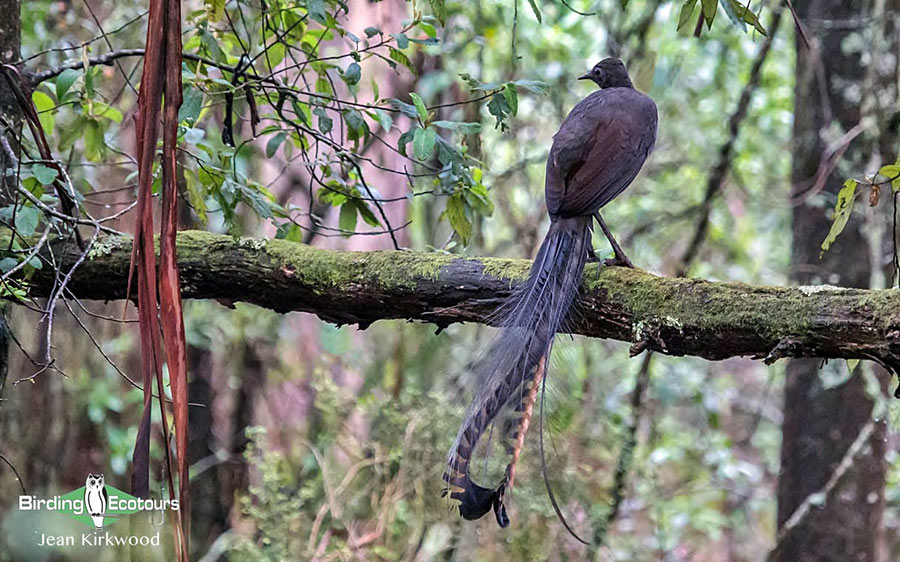
This mature male Superb Lyrebird (the largest passerine in the world) showed us just how beautiful this species in when you can get a good view. Throw in the amazing vocalizations, and it’s no wonder they are so popular!
After grabbing a quick bite to eat we made our way to the Dandenong Ranges National Park, where within seconds of pulling into the car park we were watching a beautiful male Rose Robin hopping around at our feet. A short while later it got even better as we were having dream views of a mature
male Superb Lyrebird perched on a horizontal branch at eye-level. It was fantastic to see. After the lyrebird left his perch and headed into the forest to feed we started walking through this impressive forest and were soon watching Crescent Honeyeater, Eastern Yellow Robin, Pied Currawong, and the main target of our hike, Rufous-browed Treecreeper. Afterwards a quick stop at a nearby gift shop allowed some close-up views of Sulphur-crested Cockatoos (and the purchase of some local products).
We then headed back into the city for our final dinner stop and checklist session of the trip, where we discussed what had been a fantastically enjoyable trip and selected the ‘Bird of the Trip’. Splendid Fairywren came out on top with three votes, with Plains-wanderer second with two votes and Southern Cassowary, Superb Lyrebird, and Mangrove Robin also receiving honorable mentions with one vote each.
However, we were not done quite yet, and as a special bonus after dinner we headed to the coast, where we found a small group of the delightful Little Penguins, a seriously cool way to end what had been a wonderful trip with close-up views of this rather cute (and the world’s smallest) penguin. We returned to our hotel, where we said fond farewells to our local guide Simon, without whom we would have seen a great deal less, and then headed to bed as the tour concluded.
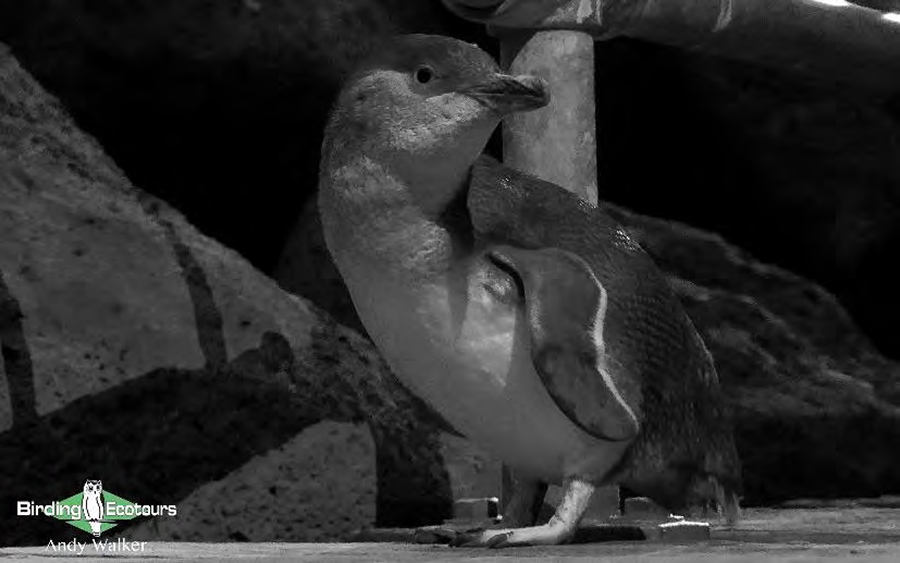
A pretty cool bird to end the tour, Little Penguin, the last new bird for the trip.
Day 0, 21st October 2018. Post-tour departure from Melbourne
After a leisurely breakfast everyone departed from Melbourne’s airport. A huge thank you to everyone for making this such an enjoyable trip! It was great fun birding with you all, and I am looking forward to the next time.
Bird List – Following IOC (8.2)
Birds ‘heard only’ are marked with (H) after the common name, all other species were seen. The following notation after species names is used to show conservation status following BirdLife International: CE = Critically Endangered, EN = Endangered, VU = Vulnerable, NT = Near Threatened. Australia endemics are bolded.
| Common Name | Scientific Name |
| Ostriches (Struthionidae) | |
| Common Ostrich | Struthio camelus |
| Cassowaries, Emu (Casuariidae) | |
| Southern Cassowary – VU | Casuarius casuarius |
| Emu | Dromaius novaehollandiae |
| Magpie Goose (Anseranatidae) | |
| Magpie Goose | Anseranas semipalmata |
| Ducks, Geese, Swans (Anatidae) | |
| Plumed Whistling Duck | Dendrocygna eytoni |
| Wandering Whistling Duck | Dendrocygna arcuata |
| Cape Barren Goose | Cereopsis novaehollandiae |
| Black Swan | Cygnus atratus |
| Freckled Duck | Stictonetta naevosa |
| Raja Shelduck | Radjah radjah |
| Australian Shelduck | Tadorna tadornoides |
| Pink-eared Duck | Malacorhynchus membranaceus |
| Maned Duck | Chenonetta jubata |
| Cotton Pygmy Goose | Nettapus coromandelianus |
| Green Pygmy Goose | Nettapus pulchellus |
| Australasian Shoveler | Spatula rhynchotis |
| Pacific Black Duck | Anas superciliosa |
| Mallard | Anas platyrhynchos |
| Grey Teal | Anas gracilis |
| Chestnut Teal | Anas castanea |
| Hardhead | Aythya australis |
| Blue-billed Duck – NT | Oxyura australis |
| Musk Duck | Biziura lobata |
| Common Name | Scientific Name |
| Megapodes (Megapodiidae) | |
| Australian Brushturkey | Alectura lathami |
| Malleefowl – VU | Leipoa ocellata |
| Orange-footed Scrubfowl | Megapodius reinwardt |
| Pheasants and Allies (Phasianidae) | |
| Brown Quail | Coturnix ypsilophora |
| Penguins (Spheniscidae) | |
| Little Penguin | Eudyptula minor |
| Albatrosses (Diomedeidae) | |
| Shy Albatross | Thalassarche cauta |
| Buller’s Albatross – NT | Thalassarche bulleri |
| Petrels, Shearwaters, Diving Petrels (Procellariidae) | |
| Short-tailed Shearwater | Ardenna tenuirostris |
| Grebes (Podicipedidae) | |
| Australasian Grebe | Tachybaptus novaehollandiae |
| Hoary-headed Grebe | Poliocephalus poliocephalus |
| Great Crested Grebe | Podiceps cristatus |
| Storks (Ciconiidae) | |
| Black-necked Stork – NT | Ephippiorhynchus asiaticus |
| Ibises, Spoonbills (Threskiornithidae) | |
| Australian White Ibis | Threskiornis molucca |
| Straw-necked Ibis | Threskiornis spinicollis |
| Glossy Ibis | Plegadis falcinellus |
| Royal Spoonbill | Platalea regia |
| Yellow-billed Spoonbill | Platalea flavipes |
| Herons, Bitterns (Ardeidae) | |
| Nankeen Night Heron | Nycticorax caledonicus |
| Striated Heron | Butorides striata |
| Eastern Cattle Egret | Bubulcus coromandus |
| Common Name | Scientific Name |
| White-necked Heron | Ardea pacifica |
| Great Egret | Ardea alba |
| Intermediate Egret | Ardea intermedia |
| White-faced Heron | Egretta novaehollandiae |
| Little Egret | Egretta garzetta |
| Pacific Reef Heron | Egretta sacra |
| Pelicans (Pelecanidae) | |
| Australian Pelican | Pelecanus conspicillatus |
| Frigatebirds (Fregatidae) | |
| Great Frigatebird | Fregata minor |
| Gannets, Boobies (Sulidae) | |
| Australasian Gannet | Morus serrator |
| Brown Booby | Sula leucogaster |
| Cormorants, Shags (Phalacrocoracidae) | |
| Little Pied Cormorant | Microcarbo melanoleucos |
| Little Black Cormorant | Phalacrocorax sulcirostris |
| Australian Pied Cormorant | Phalacrocorax varius |
| Great Cormorant | Phalacrocorax carbo |
| Anhingas, Darters (Anhingidae) | |
| Australasian Darter | Anhinga novaehollandiae |
| Ospreys (Pandionidae) | |
| Eastern Osprey | Pandion cristatus |
| Kites, Hawks, Eagles (Accipitridae) | |
| Black-shouldered Kite | Elanus axillaris |
| Black-breasted Buzzard | Hamirostra melanosternon |
| Pacific Baza | Aviceda subcristata |
| Little Eagle | Hieraaetus morphnoides |
| Wedge-tailed Eagle | Aquila audax |
| Grey Goshawk | Accipiter novaehollandiae |
| Brown Goshawk | Accipiter fasciatus |
| Common Name | Scientific Name |
| Swamp Harrier | Circus approximans |
| Black Kite | Milvus migrans |
| Whistling Kite | Haliastur sphenurus |
| Brahminy Kite | Haliastur indus |
| White-bellied Sea Eagle | Haliaeetus leucogaster |
| Bustards (Otididae) | |
| Australian Bustard | Ardeotis australis |
| Rails, Crakes and Coots (Rallidae) | |
| Buff-banded Rail | Gallirallus philippensis |
| Baillon’s Crake | Porzana pusilla |
| Australian Crake | Porzana fluminea |
| Spotless Crake | Porzana tabuensis |
| White-browed Crake | Porzana cinerea |
| Australasian Swamphen | Porphyrio melanotus |
| Dusky Moorhen | Gallinula tenebrosa |
| Black-tailed Nativehen | Tribonyx ventralis |
| Eurasian Coot | Fulica atra |
| Cranes (Gruidae) | |
| Sarus Crane – VU | Antigone antigone |
| Brolga | Antigone rubicunda |
| Stone-curlews, Thick-knees (Burhinidae) | |
| Bush Stone-curlew | Burhinus grallarius |
| Beach Stone-curlew – NT | Esacus magnirostris |
| Oystercatchers (Haematopodidae) | |
| Pied Oystercatcher | Haematopus longirostris |
| Stilts, Avocets (Recurvirostridae) | |
| Pied Stilt | Himantopus leucocephalus |
| Banded Stilt | Cladorhynchus leucocephalus |
| Red-necked Avocet | Recurvirostra novaehollandiae |
| Plovers (Charadriidae) | |
| Common Name | Scientific Name |
| Banded Lapwing | Vanellus tricolor |
| Masked Lapwing | Vanellus miles |
| Red-kneed Dotterel | Erythrogonys cinctus |
| Inland Dotterel | Peltohyas australis |
| Pacific Golden Plover | Pluvialis fulva |
| Red-capped Plover | Charadrius ruficapillus |
| Lesser Sand Plover | Charadrius mongolus |
| Greater Sand Plover | Charadrius leschenaultii |
| Hooded Dotterel – VU | Thinornis cucullatus |
| Black-fronted Dotterel | Elseyornis melanops |
| Jacanas (Jacanidae) | |
| Comb-crested Jacana | Irediparra gallinacea |
| Plains-wanderer (Pedionomidae) | |
| Plains-wanderer – CE | Pedionomus torquatus |
| Sandpipers, Snipes (Scolopacidae) | |
| Whimbrel | Numenius phaeopus |
| Far Eastern Curlew – EN | Numenius madagascariensis |
| Bar-tailed Godwit – NT | Limosa lapponica |
| Black-tailed Godwit – NT | Limosa limosa |
| Ruddy Turnstone | Arenaria interpres |
| Great Knot – EN | Calidris tenuirostris |
| Broad-billed Sandpiper | Calidris falcinellus |
| Sharp-tailed Sandpiper | Calidris acuminata |
| Curlew Sandpiper – NT | Calidris ferruginea |
| Red-necked Stint – NT | Calidris ruficollis |
| Latham’s Snipe | Gallinago hardwickii |
| Terek Sandpiper | Xenus cinereus |
| Grey-tailed Tattler – NT | Tringa brevipes |
| Marsh Sandpiper | Tringa stagnatilis |
| Common Greenshank | Tringa nebularia |
| Gulls, Terns and Skimmers (Laridae) | |
| Brown Noddy | Anous stolidus |
| Common Name | Scientific Name |
| Black Noddy | Anous minutus |
| Silver Gull | Chroicocephalus novaehollandiae |
| Pacific Gull | Larus pacificus |
| Gull-billed Tern | Gelochelidon nilotica |
| Caspian Tern | Hydroprogne caspia |
| Greater Crested Tern | Thalasseus bergii |
| Lesser Crested Tern | Thalasseus bengalensis |
| Little Tern | Sternula albifrons |
| Bridled Tern | Onychoprion anaethetus |
| Sooty Tern | Onychoprion fuscatus |
| Black-naped Tern | Sterna sumatrana |
| Whiskered Tern | Chlidonias hybrida |
| Pigeons, Doves (Columbidae) | |
| Rock Dove | Columba livia |
| White-headed Pigeon | Columba leucomela |
| Spotted Dove | Spilopelia chinensis |
| Brown Cuckoo-Dove | Macropygia phasianella |
| Pacific Emerald Dove | Chalcophaps longirostris |
| Common Bronzewing | Phaps chalcoptera |
| Brush Bronzewing | Phaps elegans |
| Crested Pigeon | Ocyphaps lophotes |
| Squatter Pigeon | Geophaps scripta |
| Wonga Pigeon | Leucosarcia melanoleuca |
| Peaceful Dove | Geopelia placida |
| Bar-shouldered Dove | Geopelia humeralis |
| Wompoo Fruit Dove | Ptilinopus magnificus |
| Superb Fruit Dove | Ptilinopus superbus |
| Rose-crowned Fruit Dove | Ptilinopus regina |
| Torresian Imperial Pigeon | Ducula spilorrhoa |
| Topknot Pigeon | Lopholaimus antarcticus |
| Cuckoos (Cuculidae) | |
| Pheasant Coucal | Centropus phasianinus |
| Pacific Koel | Eudynamys orientalis |
| Horsfield’s Bronze Cuckoo | Chrysococcyx basalis |
| Common Name | Scientific Name |
| Shining Bronze Cuckoo | Chrysococcyx lucidus |
| Little Bronze Cuckoo | Chrysococcyx minutillus |
| Pallid Cuckoo | Cacomantis pallidus |
| Fan-tailed Cuckoo | Cacomantis flabelliformis |
| Brush Cuckoo (H) | Cacomantis variolosus |
| Barn Owls (Tytonidae) | |
| Lesser Sooty Owl (H) | Tyto multipunctata |
| Eastern Barn Owl | Tyto javanica |
| Owls (Strigidae) | |
| Powerful Owl | Ninox strenua |
| Southern Boobook | Ninox boobook |
| Frogmouths (Podargidae) | |
| Papuan Frogmouth | Podargus papuensis |
| Tawny Frogmouth | Podargus strigoides |
| Owlet-nightjars (Aegothelidae) | |
| Australian Owlet-nightjar | Aegotheles cristatus |
| Swifts (Apodidae) | |
| Australian Swiftlet | Aerodramus terraereginae |
| Rollers (Coraciidae) | |
| Oriental Dollarbird | Eurystomus orientalis |
| Kingfishers (Alcedinidae) | |
| Laughing Kookaburra | Dacelo novaeguineae |
| Blue-winged Kookaburra | Dacelo leachii |
| Forest Kingfisher | Todiramphus macleayii |
| Torresian Kingfisher | Todiramphus sordidus |
| Sacred Kingfisher | Todiramphus sanctus |
| Azure Kingfisher | Ceyx azureus |
| Little Kingfisher | Ceyx pusillus |
| Bee-eaters (Meropidae) | |
| Common Name | Scientific Name |
| Rainbow Bee-eater | Merops ornatus |
| Caracaras, Falcons (Falconidae) | |
| Nankeen Kestrel | Falco cenchroides |
| Australian Hobby | Falco longipennis |
| Brown Falcon | Falco berigora |
| Peregrine Falcon | Falco peregrinus |
| Cockatoos (Cacatuidae) | |
| Red-tailed Black Cockatoo | Calyptorhynchus banksii |
| Glossy Black Cockatoo | Calyptorhynchus lathami |
| Yellow-tailed Black Cockatoo | Calyptorhynchus funereus |
| Galah | Eolophus roseicapilla |
| Major Mitchell’s Cockatoo | Lophochroa leadbeateri |
| Long-billed Corella | Cacatua tenuirostris |
| Little Corella | Cacatua sanguinea |
| Sulphur-crested Cockatoo | Cacatua galerita |
| Old World Parrots (Psittaculidae) | |
| Superb Parrot | Polytelis swainsonii |
| Regent Parrot | Polytelis anthopeplus |
| Australian King Parrot | Alisterus scapularis |
| Red-winged Parrot | Aprosmictus erythropterus |
| Red-rumped Parrot | Psephotus haematonotus |
| Eastern Bluebonnet | Northiella haematogaster |
| Mulga Parrot | Psephotellus varius |
| Crimson Rosella | Platycercus elegans |
| Pale-headed Rosella | Platycercus adscitus |
| Eastern Rosella | Platycercus eximius |
| Australian Ringneck | Barnardius zonarius |
| Blue-winged Parrot | Neophema chrysostoma |
| Turquoise Parrot | Neophema pulchella |
| Little Lorikeet | Parvipsitta pusilla |
| Purple-crowned Lorikeet | Parvipsitta porphyrocephala |
| Rainbow Lorikeet | Trichoglossus moluccanus |
| Scaly-breasted Lorikeet | Trichoglossus chlorolepidotus |
| Common Name | Scientific Name |
| Musk Lorikeet | Glossopsitta concinna |
| Double-eyed Fig Parrot | Cyclopsitta diophthalma |
| Pittas (Pittidae) | |
| Noisy Pitta (H) | Pitta versicolor |
| Lyrebirds (Menuridae) | |
| Albert’s Lyrebird – NT | Menura alberti |
| Superb Lyrebird | Menura novaehollandiae |
| Bowerbirds (Ptilonorhynchidae) | |
| Green Catbird | Ailuroedus crassirostris |
| Spotted Catbird | Ailuroedus maculosus |
| Tooth-billed Bowerbird | Scenopoeetes dentirostris |
| Regent Bowerbird | Sericulus chrysocephalus |
| Satin Bowerbird | Ptilonorhynchus violaceus |
| Great Bowerbird | Chlamydera nuchalis |
| Australasian Treecreepers (Climacteridae) | |
| White-throated Treecreeper | Cormobates leucophaea |
| Red-browed Treecreeper | Climacteris erythrops |
| White-browed Treecreeper | Climacteris affinis |
| Brown Treecreeper | Climacteris picumnus |
| Australasian Wrens (Maluridae) | |
| Purple-backed Fairywren | Malurus assimilis |
| Variegated Fairywren | Malurus lamberti |
| Superb Fairywren | Malurus cyaneus |
| Splendid Fairywren | Malurus splendens |
| Red-backed Fairywren | Malurus melanocephalus |
| White-winged Fairywren | Malurus leucopterus |
| Southern Emu-wren | Stipiturus malachurus |
| Mallee Emu-wren – EN | Stipiturus mallee |
| Striated Grasswren | Amytornis striatus |
| Honeyeaters (Meliphagidae) | |
| Common Name | Scientific Name |
| Black Honeyeater | Sugomel niger |
| Dusky Myzomela | Myzomela obscura |
| Scarlet Myzomela | Myzomela sanguinolenta |
| Tawny-crowned Honeyeater | Gliciphila melanops |
| Eastern Spinebill | Acanthorhynchus tenuirostris |
| Brown Honeyeater | Lichmera indistincta |
| Crescent Honeyeater | Phylidonyris pyrrhopterus |
| New Holland Honeyeater | Phylidonyris novaehollandiae |
| White-cheeked Honeyeater | Phylidonyris niger |
| Painted Honeyeater – VU | Grantiella picta |
| Striped Honeyeater | Plectorhyncha lanceolata |
| Macleay’s Honeyeater | Xanthotis macleayanus |
| Little Friarbird | Philemon citreogularis |
| Hornbill Friarbird | Philemon yorki |
| Noisy Friarbird | Philemon corniculatus |
| Blue-faced Honeyeater | Entomyzon cyanotis |
| Black-chinned Honeyeater | Melithreptus gularis |
| Brown-headed Honeyeater | Melithreptus brevirostris |
| White-throated Honeyeater | Melithreptus albogularis |
| White-naped Honeyeater | Melithreptus lunatus |
| White-eared Honeyeater | Nesoptilotis leucotis |
| Orange Chat | Epthianura aurifrons |
| White-fronted Chat | Epthianura albifrons |
| Brown-backed Honeyeater | Ramsayornis modestus |
| Spiny-cheeked Honeyeater | Acanthagenys rufogularis |
| Little Wattlebird | Anthochaera chrysoptera |
| Red Wattlebird | Anthochaera carunculata |
| Bridled Honeyeater | Bolemoreus frenatus |
| Yellow-faced Honeyeater | Caligavis chrysops |
| Yellow-tufted Honeyeater | Lichenostomus melanops |
| Bell Miner | Manorina melanophrys |
| Noisy Miner | Manorina melanocephala |
| Yellow-throated Miner | Manorina flavigula |
| White-fronted Honeyeater | Purnella albifrons |
| Yellow Honeyeater | Stomiopera flava |
| Common Name | Scientific Name |
| Varied Honeyeater | Gavicalis versicolor |
| Singing Honeyeater | Gavicalis virescens |
| Fuscous Honeyeater | Ptilotula fusca |
| Yellow-plumed Honeyeater | Ptilotula ornata |
| White-plumed Honeyeater | Ptilotula penicillata |
| Graceful Honeyeater | Meliphaga gracilis |
| Yellow-spotted Honeyeater | Meliphaga notata |
| Lewin’s Honeyeater | Meliphaga lewinii |
| Bristlebirds (Dasyornithidae) | |
| Rufous Bristlebird | Dasyornis broadbenti |
| Pardalotes (Pardalotidae) | |
| Spotted Pardalote | Pardalotus punctatus |
| Striated Pardalote | Pardalotus striatus |
| Australasian Warblers (Acanthizidae) | |
| Fernwren | Oreoscopus gutturalis |
| Pilotbird | Pycnoptilus floccosus |
| Shy Heathwren | Calamanthus cautus |
| Striated Fieldwren | Calamanthus fuliginosus |
| Rufous Fieldwren | Calamanthus campestris |
| Speckled Warbler | Pyrrholaemus sagittatus |
| Atherton Scrubwren | Sericornis keri |
| White-browed Scrubwren | Sericornis frontalis |
| Yellow-throated Scrubwren | Sericornis citreogularis |
| Large-billed Scrubwren | Sericornis magnirostra |
| Weebill | Smicrornis brevirostris |
| Brown Gerygone | Gerygone mouki |
| Mangrove Gerygone | Gerygone levigaster |
| Western Gerygone | Gerygone fusca |
| Large-billed Gerygone | Gerygone magnirostris |
| White-throated Gerygone | Gerygone olivacea |
| Fairy Gerygone | Gerygone palpebrosa |
| Mountain Thornbill | Acanthiza katherina |
| Brown Thornbill | Acanthiza pusilla |
| Common Name | Scientific Name |
| Inland Thornbill | Acanthiza apicalis |
| Chestnut-rumped Thornbill | Acanthiza uropygialis |
| Buff-rumped Thornbill | Acanthiza reguloides |
| Yellow-rumped Thornbill | Acanthiza chrysorrhoa |
| Yellow Thornbill | Acanthiza nana |
| Striated Thornbill | Acanthiza lineata |
| Southern Whiteface | Aphelocephala leucopsis |
| Australasian Babblers (Pomatostomidae) | |
| Grey-crowned Babbler | Pomatostomus temporalis |
| White-browed Babbler | Pomatostomus superciliosus |
| Chestnut-crowned Babbler | Pomatostomus ruficeps |
| Logrunners (Orthonychidae) | |
| Australian Logrunner | Orthonyx temminckii |
| Chowchilla | Orthonyx spaldingii |
| Whipbirds, Jewel-babblers, Quail-thrushes (Psophodidae) | |
| Eastern Whipbird | Psophodes olivaceus |
| Boatbills (Machaerirhynchidae) | |
| Yellow-breasted Boatbill | Machaerirhynchus flaviventer |
| Woodswallows, Butcherbirds and Allies (Artamidae) | |
| White-breasted Woodswallow | Artamus leucorynchus |
| Masked Woodswallow | Artamus personatus |
| White-browed Woodswallow | Artamus superciliosus |
| Dusky Woodswallow | Artamus cyanopterus |
| Black Butcherbird | Melloria quoyi |
| Australian Magpie | Gymnorhina tibicen |
| Grey Butcherbird | Cracticus torquatus |
| Pied Butcherbird | Cracticus nigrogularis |
| Pied Currawong | Strepera graculina |
| Grey Currawong | Strepera versicolor |
| Cuckooshrikes (Campephagidae) | |
| Common Name | Scientific Name |
| Barred Cuckooshrike | Coracina lineata |
| Black-faced Cuckooshrike | Coracina novaehollandiae |
| White-bellied Cuckooshrike | Coracina papuensis |
| White-winged Triller | Lalage tricolor |
| Varied Triller | Lalage leucomela |
| Sittellas (Neosittidae) | |
| Varied Sittella | Daphoenositta chrysoptera |
| Australo-Papuan Bellbirds (Oreoicidae) | |
| Crested Bellbird (H) | Oreoica gutturalis |
| Whistlers and allies (Pachycephalidae) | |
| Crested Shriketit | Falcunculus frontatus |
| Olive Whistler | Pachycephala olivacea |
| Gilbert’s Whistler | Pachycephala inornata |
| Grey Whistler | Pachycephala simplex |
| Australian Golden Whistler | Pachycephala pectoralis |
| Rufous Whistler | Pachycephala rufiventris |
| Bower’s Shrikethrush | Colluricincla boweri |
| Little Shrikethrush | Colluricincla megarhyncha |
| Grey Shrikethrush | Colluricincla harmonica |
| Figbirds, Orioles & Turnagra (Oriolidae) | |
| Australasian Figbird | Sphecotheres vieilloti |
| Olive-backed Oriole | Oriolus sagittatus |
| Green Oriole | Oriolus flavocinctus |
| Drongos (Dicruridae) | |
| Spangled Drongo | Dicrurus bracteatus |
| Fantails (Rhipiduridae) | |
| Willie Wagtail | Rhipidura leucophrys |
| Grey Fantail | Rhipidura albiscapa |
| Rufous Fantail | Rhipidura rufifrons |
| Monarchs (Monarchidae) | |
| Common Name | Scientific Name |
| Spectacled Monarch | Symposiachrus trivirgatus |
| Black-faced Monarch | Monarcha melanopsis |
| White-eared Monarch | Carterornis leucotis |
| Pied Monarch | Arses kaupi |
| Magpie-lark | Grallina cyanoleuca |
| Leaden Flycatcher | Myiagra rubecula |
| Shining Flycatcher | Myiagra alecto |
| Restless Flycatcher | Myiagra inquieta |
| Crows, Jays (Corvidae) | |
| Torresian Crow | Corvus orru |
| Little Raven | Corvus mellori |
| Australian Raven | Corvus coronoides |
| Australian Mudnesters (Corcoracidae) | |
| White-winged Chough | Corcorax melanorhamphos |
| Apostlebird | Struthidea cinerea |
| Birds-of-paradise (Paradisaeidae) | |
| Paradise Riflebird (H) | Ptiloris paradiseus |
| Victoria’s Riflebird | Ptiloris victoriae |
| Australasian Robins (Petroicidae) | |
| Grey-headed Robin | Heteromyias cinereifrons |
| White-browed Robin | Poecilodryas superciliosa |
| Mangrove Robin | Peneoenanthe pulverulenta |
| Pale-yellow Robin | Tregellasia capito |
| Eastern Yellow Robin | Eopsaltria australis |
| Hooded Robin | Melanodryas cucullata |
| Jacky Winter | Microeca fascinans |
| Rose Robin | Petroica rosea |
| Pink Robin | Petroica rodinogaster |
| Flame Robin – NT | Petroica phoenicea |
| Red-capped Robin | Petroica goodenovii |
| Southern Scrub Robin | Drymodes brunneopygia |
| Common Name | Scientific Name |
| Larks (Alaudidae) | |
| Horsfield’s Bush Lark | Mirafra javanica |
| Eurasian Skylark | Alauda arvensis |
| Swallows, Martins (Hirundinidae) | |
| White-backed Swallow | Cheramoeca leucosterna |
| Welcome Swallow | Hirundo neoxena |
| Fairy Martin | Petrochelidon ariel |
| Tree Martin | Petrochelidon nigricans |
| Reed Warblers and Allies (Acrocephalidae) | |
| Australian Reed Warbler | Acrocephalus australis |
| Grassbirds and Allies (Locustellidae) | |
| Little Grassbird | Poodytes gramineus |
| Rufous Songlark | Cincloramphus mathewsi |
| Tawny Grassbird | Cincloramphus timoriensis |
| Cisticolas and Allies (Cisticolidae) | |
| Golden-headed Cisticola | Cisticola exilis |
| White-eyes (Zosteropidae) | |
| Silvereye | Zosterops lateralis |
| Starlings, Rhabdornis (Sturnidae) | |
| Metallic Starling | Aplonis metallica |
| Common Myna | Acridotheres tristis |
| Common Starling | Sturnus vulgaris |
| Thrushes (Turdidae) | |
| Russet-tailed Thrush | Zoothera heinei |
| Bassian Thrush | Zoothera lunulata |
| Common Blackbird | Turdus merula |
| Flowerpeckers (Dicaeidae) | |
| Mistletoebird | Dicaeum hirundinaceum |
| Common Name | Scientific Name |
| Sunbirds (Nectariniidae) | |
| Olive-backed Sunbird | Cinnyris jugularis |
| Old World Sparrows, Snowfinches (Passeridae) | |
| House Sparrow | Passer domesticus |
| Eurasian Tree Sparrow | Passer montanus |
| Waxbills, Munias and Allies (Estrildidae) | |
| Diamond Firetail | Stagonopleura guttata |
| Red-browed Finch | Neochmia temporalis |
| Crimson Finch | Neochmia phaeton |
| Zebra Finch | Taeniopygia guttata |
| Double-barred Finch | Taeniopygia bichenovii |
| Scaly-breasted Munia | Lonchura punctulata |
| Chestnut-breasted Mannikin | Lonchura castaneothorax |
| Wagtails, Pipits (Motacillidae) | |
| Australian Pipit | Anthus australis |
| Finches, Euphonias (Fringillidae) | |
| European Greenfinch | Chloris chloris |
| European Goldfinch | Carduelis carduelis |
| Total Seen | 390 |
| Total Heard Only | 5 |
| Total Recorded | 395 |
Mammal List
| Common Name | Scientific Name |
| Cats (Felisdae) | |
| Domestic (Feral) Cat | Felis catus |
| Dolphins (Delphinidae) | |
| Common Bottlenose Dolphin | Tursiops truncatus |
| Old World Fruit Bats (Pteropodidae) | |
| Common Name | Scientific Name |
| Spectacled Flying Fox | Pteropus conspicillatus |
| Little Red Flying Fox | Pteropus scapulatus |
| Dasyurids (Dasyuridae) | |
| Yellow-footed Antechinus | Antechinus flavipes |
| Fat-tailed Dunnart | Sminthopsis crassicaudata |
| Musky Rat Kangaroo (Hypsiprymnodontidae) | |
| Musky Rat Kangaroo | Hypsiprymnodon moschatus |
| Kangaroos, Wallabies, and Relatives (Macropodidae) | |
| Lumholtz’s Tree Kangaroo | Dendrolagus lumholtzi |
| Agile Wallaby | Macropus agilis |
| Western Gray Kangaroo | Macropus fuliginosus |
| Eastern Gray Kangaroo | Macropus giganteus |
| Whiptail Wallaby | Macropus parryi |
| Red Kangaroo | Macropus rufus |
| Red-legged Pademelon | Thylogale stigmatica |
| Red-necked Pademelon | Thylogale thetis |
| Swamp Wallaby | Wallabia bicolor |
| Gliders and Striped Possums (Petauridae) | |
| Striped Possum | Dactylopsila trivirgata |
| Yellow-bellied Glider | Petaurus australis |
| Sugar Glider | Petaurus breviceps |
| (Southern) Greater Glider | Petauroides volans |
| Brushtail Possums and Cuscuses (Phalangeridae) | |
| Common Brushtail Possum | Trichosurus vulpecula |
| Koalas (Phascolarctidae) | |
| Koala | Phascolarctos cinereus |
| Ringtail Possums (Pseudocheiridae) | |
| Common Ringtail Possum | Pseudocheirus peregrinus |
| Green Ringtail Possum | Pseudochirops archeri |
| Common Name | Scientific Name |
| Wombats (Vombatidae) | |
| Common Wombat | Vombatus ursinus |
| Hares and Rabbits (Leporidae) | |
| European Hare | Lepus europaeus |
| European Rabbit | Oryctolagus cuniculus |
| Platypus (Ornithorhynchidae) | |
| Platypus | Ornithorhynchus anatinus |
| Echidnas (Tachyglossidae) | |
| Short-beaked Echidna | Tachyglossus aculeatus |
| Bandicoots and Echymiperas (Peramelidae) | |
| Northern Brown Bandicoot | Isoodon macrourus |
| Old World Mice and Allies (Muridae) | |
| Common Water Rat | Hydromys chrysogaster |
| Fawn-footed Melomys | Melomys cervinipes |
| House Mouse | Mus musculus |
| White-tailed Giant Rat | Uromys caudimaculatus |
| Total seen | 34 |
Reptile List
| Common Name | Scientific Name |
| Crocodiles (Crocodylidae) | |
| Saltwater Crocodile | Crocodylus porosus |
| Geckos (Gekkonidae) | |
| Common House Gecko | Hemidactylus frenatus |
| Dragons (Agamidae) | |
| Mallee (Military) Dragon | Ctenophorus fordi |
| Boyd’s Forest Dragon | Hypsilurus boydii |
| Eastern Water Dragon | Intellagama lesueurii |
| Central Bearded Dragon | Pogona vitticeps |
| Common Name | Scientific Name |
| Monitors (Varanidae) | |
| Banded (Spotted) Tree Monitor | Varanus scalaris |
| Lace Monitor | Varanus varius |
| Skinks (Scincidae) | |
| Royal (Pale-rumped) Ctenotus | Ctenotus regius |
| Eastern Water-skink | Eulamprus quoyii |
| Shingleback Lizard | Tiliqua rugosa |
| Common Bluetongue Skink | Tiliqua scincoides |
| Colubrid snakes (Colubridae) | |
| Common (Green) Tree Snake | Dendrelaphis punctulatus |
| Sea turtles (Cheloniidae) | |
| Green Turtle | Chelonia mydas |
| Freshwater turtles (Cheluidae) | |
| Murray River Turtle | Emydura macquarii |
| Saw-shelled Turtle | Wollumbinia latisternum |
| Total seen | 16 |
Amphibian List
| Common Name | Scientific Name |
| Marsh Frogs (Limnodynastidae) | |
| Eastern Banjo Frog | Limnodynastes dumerilii |
| Common Spadefoot Frog | Neobatrachus sudellae |
| Tree Frogs (Hylidae) | |
| Green Tree Frog | Litoria caerulea |
| White-lipped Tree Frog | Nyctimystes infrafrenatus |
| Toads (Bufonidae) | |
| Cane Toad | Rhinella marina |
| Total seen | 5 |
This is a sample trip report. Please email us ([email protected]) for more trip reports from this destination.
